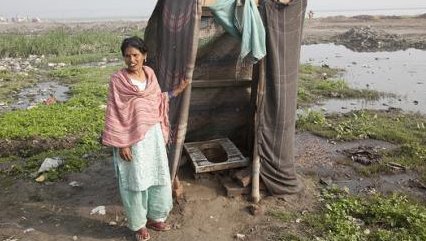NEW DELHI (GPI)-- Each dawn brings the same battle for Sangeeta Devi. The simple act of defecation takes tactful planning for the 30-year-old. For Devi, a local community worker, it’s a matter of life or death. Devi, like the other women of her slum, lacks a toilet in her home. So she wakes up early when it’s still dark, walks toward the bushes on the edge of the slum and squats there to relieve herself. “A few girls were raped on their way to the vacant park near the slum, where they had gone to defecate.” Maya Rajasthani, resident of a New Delhi slum The daily humiliation is taking a toll on her dignity, she says. But open defecation is more than embarrassing. Often, men hide in the areas women commonly use to go to the bathroom, knowing that this is a position and time when they are vulnerable. “Once, a few men put a blanket over me and tried to kidnap me,” Devi says. “I shouted at the top of my voice, and somehow, I managed to escape. But everyone is not lucky like me.” Devi doesn’t live in poverty-stricken rural India, but right in the heart of the national capital, New Delhi. Her slum, Kirbi Place, is home to migrant laborers from poor northern states. Representative of urban poverty, it lacks sanitation and other basic amenities like scores of other unregistered New Delhi slums. Inadequate sanitation forces women in both rural and urban areas of India to defecate in the open, leaving them vulnerable to sexual violence. Lack of toilets or maintenance of them also creates health hazards. It forces girls to drop out of school and women to quit their jobs. Some women have improved sanitation in their communities by advocating for change. The government proposes a public-private system in response to citizen demands for the prioritization of sanitation, especially in the city’s slums. Jairam Ramesh, minister of drinking water and sanitation, recently presented to Parliament that 60 percent of India's population and 70 percent of women don’t have access to a toilet. In July 2012, he deemed India the world's capital of open defecation, according to local media. He also checked excitement about successful missile tests by lamenting that there is no use launching missiles if there are no toilets for women. The capital is not exempt from the toilet troubles. New Delhi has only 132 public toilets for women, while men have 1,534, according to a 2009 report by the Centre for Civil Society, a nongovernmental research and educational organization devoted to improving citizens’ quality of life. Suman Chahar, an expert in environmental sanitation and public health, has been working closely with communities in New Delhi, including Devi’s, for the past 17 years. “This is a very grave and daily issue, particularly for these women,” Chahar says of open defecation. “It concerns their security, health and dignity. Along with shocking incidents of rape and molestation and lewd remarks, I have heard shocking stories of what all these women go through if accidentally they found a man from their community ‘sitting’ next to them in the row.” The “row” is the line women form outside in the morning and evening to relieve themselves. Maya Rajasthani, 36, a resident of Rajiv Gandhi Camp, a former refugee camp that is now a slum in New Delhi, describes how the people there lived without a toilet for nearly 25 years. “While cases of molestation were common, things got ugly when a few girls were raped on their way to the vacant park near the slum, where they had gone to defecate,” the mother of three says. Bindeshwar Pathak, founder of Sulabh International Social Service Organisation, a nongovernmental organization working to make cost-effective toilets available to rural communities, is a pioneer in India's sanitation movement and has been working in the field for the last four decades.
Advertisement















